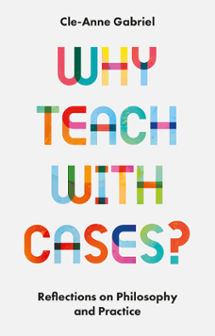
Index
Cle-Anne Gabriel
(The University of Queensland, Australia)
ISBN: 978-1-80382-400-0, eISBN: 978-1-80382-397-3
Publication date: 7 November 2022
This content is currently only available as a PDF
Citation
Gabriel, C.-A. (2022), "Index", Why Teach With Cases?, Emerald Publishing Limited, Leeds, pp. 139-141. https://doi.org/10.1108/978-1-80382-397-320221011
Publisher
:Emerald Publishing Limited
Copyright © 2023 Cle-Anne Gabriel. Published under exclusive licence by Emerald Publishing Limited
INDEX
Adaptive leadership
, 65, 67, 69
Aldi
, 43–44
Apple
, 43–44
Australian Awards for University Teaching (AAUT)
, 5
Australian Broadcasting Corporation (ABC)
, 34
Backward why-questioning
, 47, 133
#BlackLivesMatter protests
, 42
Bloom’s taxonomy of educational objectives
, 54–55
Business
cases
, 4–5
educators
, 20
Carbon neutrality
, 4–5
Case Method
, 3–5, 11, 14, 19, 22, 42
in classrooms
, 53–54
experiential value
, 54–55
knowledge or experience
, 65
as signature pedagogy
, 22–27
structure and formalised approach
, 53
true believers
, 70
Case teaching
, 51
patterns
, 66
stages of adaptive leadership
, 67–69
team
, 65
Case Writing Workshop
, 70–71
Case-based learning
, 10, 51
assessment
, 58–63
Case-teaching resources
feedback templates
, 106
forward-vs. backward-why questioning
, 133
individual case analysis report
, 81, 95, 100–101
instructions and rubrics
, 75
leadership case study based on Everest simulation
, 118–127
teaching team
, 108, 114
team-based case analysis
, 75
team-based report and presentation
, 78–81
why questioning
, 133
worksheets to accompany case study based on Everest simulation
, 129
Cases
, 10–11
analysis report
, 62–63
case-based learners
, 20
case-based teaching and learning
, 3–5
ceding authority in case discussions
, 14–15
exam
, 63
finding and accessing
, 12–13
integrating cases in existing course
, 13–14
Ceding authority in case discussions
, 14–15
Chief Sustainability Officer (CSO)
, 81
Conceptualisation
, 25
Decision time
, 127
Discipline pedagogy
, 17
Discomfort
, 57
Discussion pastures
, 13–14, 53–54
Educators
, 44
pedagogy
, 17
Efficiency
, 7
Engagement
, 6–7
Everest simulation
decision time
, 127
leadership case study based on
, 118, 127
setup
, 118–119
synopsis
, 118
team
, 119, 123, 127
worksheets to accompany case study based on
, 129
Feedback templates
, 106
whole-cohort feedback template
, 106–108
Fellow practitioners
, 4
Forward why-questioning
, 45, 133
Group of Eight universities (Go8 universities)
, 40–42
Harvard Business School (HBS)
, 20
Higher education institutions (HE institutions)
, 4
Implicit and deep structures
, 33–35
evidence of success
, 35–40
preparing to teach with cases
, 40–42
selecting right cases
, 43–44
In-class team-based assessment
, 58–62
Inclusivity
, 7
Individual case analysis report
, 81, 87, 90, 95, 100–101
assignment
, 85–86
C-Suite
, 81–87
essentials
, 84–85
note
, 81
task
, 84
Instructions for case-based assessment
, 75
Issue identification
, 44–45
Jigsaw technique
, 15, 57–58
Leadership case study based on Everest simulation
, 118–127
Learners
, 4, 9, 13, 44–45
Learning
, 9–10, 52
Master of Business Administration (MBA)
, 3–4
learners
, 26
students
, 37–38
McDonald
, 43–44
‘Net Zero’ commitments
, 4–5
North American Case Research Association (NACRA)
, 5
Paul R Lawrence Fellowship Case Research Foundation
, 5
Pedagogy
, 17
Case Method
, 19, 22, 27
signature pedagogy
, 17–19
PESTEL
, 117
Real-world applicability
, 6
Rubrics for case-based assessment
, 75
Scaffolding Case Method
, 43–44
Senior Tutor
, 66–69
Signature pedagogy
, 17–19
Case Method as
, 22–27
Simulation
, 63
Skill development
, 55–56
Skill pastures
, 13–14, 54–55
into classroom activities
, 56–58
Small group discussions (SGDs)
, 53–54
benefits
, 55
Small-and medium-sized enterprises (SMEs)
, 3–4
Socratic approach
, 20
Socratic dialogue techniques
, 20–21
Socratic questioning techniques
, 8, 13–14, 133
Speed
, 7
Student representatives
, 52
Surface structures
, 34
assessing case-based learning
, 58–63
facilitating case-based discussion
, 53–56
skill pastures into classroom activities
, 56–58
Teaching
, 8–9
with cases
, 3–7
philosophy
, 7–15
Teaching team
, 108, 114
team-based feedback templates
, 114–117
whole-cohort feedback template
, 108–114
Team-based case analysis
, 75
Team-based feedback templates
, 114–117
Team-based learning
, 51
Team-based report and presentation
, 78–81
choice of organisations and sources of information
, 78
presentation
, 81
structure
, 78–80
written report
, 80
Theory-application-implication framework (TAI framework)
, 35
Uber
, 43–44
University of Queensland (UQ)
, 22–23, 37–38, 51, 118
University of Queensland Business School (UQBS)
, 13
Versatility
, 6
Whole-cohort feedback template
feedback templates
, 106–108
teaching team
, 108–114
Why-questioning technique
, 39–40, 44, 48, 133
Worksheets to accompany case study based on Everest simulation
, 129
Yushan Bicycles
, 100–101
- Prelims
- Section I Theory (Why I Teach With Cases)
- 1 Why I Teach With Cases
- 2 The Case for Cases as Pedagogy
- Section II Practice (How I Teach With Cases)
- 3 Implicit and Deep Structures: Case Selection and Preparation
- 4 Building Surface Structures
- 5 Leading a Case Teaching Team
- Section III Useful Resources
- 6 Useful Case-Teaching Resources
- Index